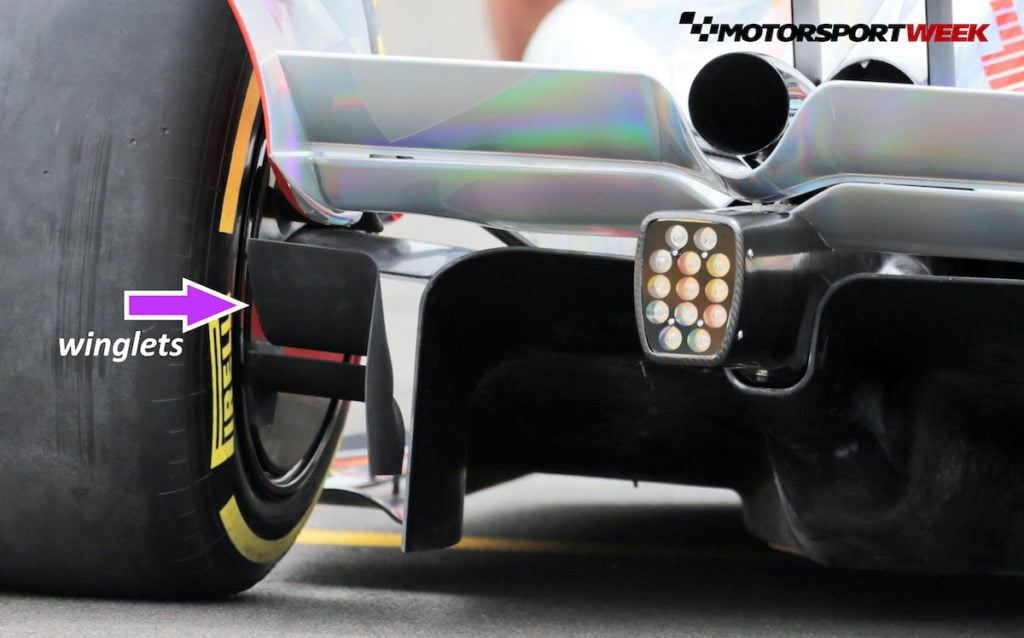PART 2 - Front wing
The front wing of the 2022 cars is operationally fairly similar to the wings pioneered by Alfa Romeo and Alpha Tauri after the 2019 F1 rule change, but through regulation rather than innovation, with a lot of camber towards the middle of the wing with very little camber at the tips. There are some obvious differences, for example the wing now rises to join the nose directly rather than hanging underneath from pylons, to remove the Y250 vortex which is so influential in current car aerodynamic designs, and the larger delta shaped endplates which blend into the wing.

The front wing is split into four boxes to delineate the regulations for each section. The front wing retains the rearwards sweep introduced in the 2017 rule change to make the cars look more “dynamic”, though the angle of sweep has increased from around 11° to about 21° -
extra dynamic! To join to the nose the front wing has a small anhedral angle, or droop, of about 2.6° from centreline to tip (though there is a small dip allowed near the nose), where the wing is closest to the ground - the minimum height above

being 100mm, 25mm higher than the current wings. The slight increase in height reduces the ground effect of the wing, reducing absolute downforce but also pitch sensitivity.
- RV-FW-PROFILES Front Wing Reference Volume
- RV-FW-EP Front Wing Reference Volume
- RV-FW-TIP Front Wing Reference Volume
- RV-FW-DP Front Wing Diveplane Reference Volume
- RS-FWEP-BODY Front Wing Endplate Body Reference Surface
- RS-FW-PROFILES Front Wing Profiles Reference Surface
- RS-FW-DP Front Wing Diveplane Reference Surface
- RS-FW-SECTION Front Wing Profiles Reference Section
The actual downforce producing elements of the wing must fit inside RV-FW-PROFILES (orange below). The number of separate wing elements is limited to a maximum of four, one fewer than 2019-21, which have to stack consecutively from lowest to highest with minimum and maximum separation between each of 5mm and 15mm respectively. Like the past few years of regulations the front wings have a number of geometry restrictions in the rules, like minimum convex curvature of the aerofoil profiles (50mm) and maximum tangents to the slope created across the span. For structural reasons, the foremost two aerofoil elements must be at least 25mm thick at their maximum point of thickness, though only inboard of Y300 (±300mm from

). The two foremost aerofoil elements must also be fixed relative to the nose, so that only the upper two (if using all four elements) elements are able to change angle to adjust downforce levels at the track, with flap adjustment handled in the same way as 2019-21 with a little fence allowed to “seal” the end of the flap. The inboard axis of rotation can be between 200mm to 400mm from

, while the outboard rotation point must be between 825 and 850mm from

.

Like the floor there is a minimum planform area to which the wing must conform, the triangular(ish) shape of RS-FW-PROFILES (red below) must be hidden by the front wing. The front edge of RS-FW-PROFILES is slightly inset from RV-FW-PROFILES with a slightly smaller sweep angle. The outboard edge is then the same length as the lower edge of the minimum size requirement of the endplate (RS-FWEP-BODY, teal below).

The front wing endplate must fit within RV-FW-EP (blue above) and must also be bigger than the delta shaped RS-FWEP-BODY when viewed from the side. Like the floor fences described above, the endplate is defined relative to a “virtual surface” which can be offset by ±6mm, or ±10mm over the leading 150mm of the endplate. The virtual surface cannot out or inwash flow by more than 10° from the car centreline at any point along its length - again to keep the car wake narrow for raceability. The endplate must then have a radius of at least 5mm applied to all edges to prevent punctures - this rule has existed for a long time - furthermore the whole endplate must be made of a prescribed laminate to prevent splintering so that if the worst does happen punctures are not caused by sharp carbon fibre shards.
After the endplate and wing profiles are fully defined the wing profiles have to be blended into the endplate inside RV-FW-TIP (grey above). The tip volume can still contain up to four elements, but these must have merged into one at the bottom of the endplate. The maximum slot gap separation from the profiles volume is still present, but the wing elements here cannot overlap by more than 30mm. The blend radius has to be bigger than a 20mm arc, preventing any sharp corners which could produce undesired vortices.
The last part of the front wing group is the diveplane. The diveplane will produce a bit of downforce but also sheds a vortex which runs along the outer face of the front tyre. While the maximum width of the front wing at the endplate is 1950mm, the diveplane volume (RV-FW-DP, green above) takes the width of the completed front wing to the full 2m width of the car. The diveplane is again quite tightly controlled, being defined from another “virtual surface”, the trailing edge of which must be at least 75mm above the leading edge. The diveplane must form a single curve (no inflection), and cannot have any radius of curvature less than 50mm. The diveplane outboard of the endplate must also cover RS-FW-DP (purple above) when viewed from above. Once the virtual surface is defined the actual diveplane has to be between 10mm and 12mm thick, with a radius of at least 5mm applied to the edge - to prevent punctures.

).






